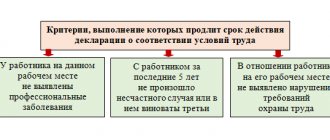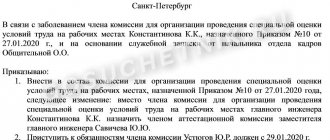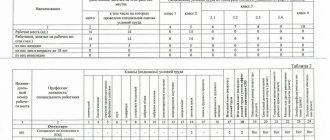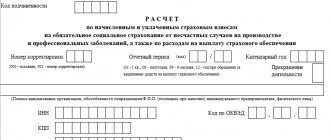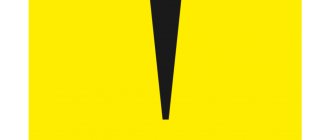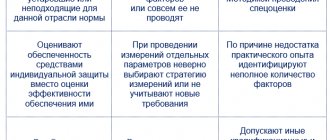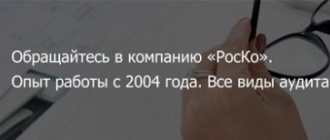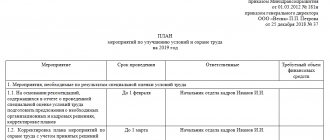In 2021, issues related to the implementation of SOUTH at enterprises are becoming very relevant. This is due to the fact that 5 years have passed since the entry into force of the law on the mandatory implementation of special labor safety measures - the period during which the results of a previously conducted assessment of the quality and safety of working conditions under the previously valid legislation were taken into account. According to Valery Korzh, who holds the position of director in the Department for Safety and Labor Protection of Workers of the Ministry of Labor of the Russian Federation, in 2020, enterprises will be inspected to determine the availability of the results of the special labor safety assessment. Although it is immediately planned to only send out warnings about violations of the law, this may later threaten enterprises with sanctions in the form of fines.
What should be understood by SOUT
A special assessment of working conditions is a whole complex of measures carried out one after another aimed at identifying dangerous and/or harmful factors in the production environment and assessing the degree of their impact on the employee, taking into account the actual values of their deviations from the standards approved by the Government of the Russian Federation for the organization of safe working conditions.
Federal Law dated December 28, 2013 No. 426-FZ classifies almost all workplaces at enterprises, organizations, firms into a category for which it is mandatory to evaluate the working conditions provided to employees according to a special scheme, with the exception of the following cases.
For which categories of employees is it allowed not to carry out a special procedure for assessing the provided working conditions for employees (clause 3, article 3 of the Federal Law of December 28, 2013 No. 426-FZ)
- employees working remotely;
- workers working from home (homeworkers);
- workers whose employers are not individual entrepreneurs;
- workers whose employers are religious organizations.
In addition, there is a legally established list of individual places of work in enterprises with certain types of activities that have specific properties, for which a special procedure must also be carried out to assess the proposed working conditions for workers (Resolution of the Government of the Russian Federation dated April 14, 2014 No. 290 ). Carrying out a special procedure for assessing the impact of working conditions on an employee in such cases is carried out taking into account those features that are established by the authorized body of the federal executive power.
List of enterprises (departments) that carry out certain types of activities, when conducting a special procedure for assessing the impact of working conditions of workplaces on employees where the features established by the federal executive body apply:
- Vessels:
– sea;
– river;
– inland navigation vessels;
- engaged in fishing.
- Civil aviation vessels.
- Organizations providing emergency (specialized) care.
- Intensive care units, intensive care units, operating rooms.
- Departments of medical institutions for performing diagnostics and direct treatment using special medical equipment (instruments, devices, equipment, etc.).
- Organizations that prepare for sports competitions.
- Media, theaters, circuses, etc.
- Enterprises with nuclear and radiation hazardous industries.
- Enterprises related to organizing the work of divers.
- Enterprises whose activities are carried out in the field of extreme exposure to the gas environment and air environment.
- Enterprises associated with underground work.
- City passenger transport.
- Medical departments providing assistance to patients with mental disorders.
- Enterprises that operate in the areas of manufacturing, testing, processing, disposal and storage of explosives.
Name of workplace for SOUT
Correctly entering the names of jobs into the list is as important as the correct number. According to the instructions approved by Order of the Ministry of Labor of Russia dated January 24, 2014 No. 33n, the name of the position in the documentation for a special assessment of working conditions must completely coincide with its counterpart recorded in the staffing table of the enterprise.
It happens that the commission, for reasons of trade secrets, provides the expert organization on SOUT with a list of jobs that does not correspond to the original staffing table. However, in the process of further application of the results of the special assessment when assigning benefits and guarantees, it turns out that not all jobs were covered by the special assessment.
In such situations, inspections may turn into legal proceedings, leading to the conclusion that the implementation of the special assessment system is incomplete due to the lack of information on individual positions. Such oversights can only be avoided by carefully monitoring the coincidence of the names included in the SOUT materials with the positions recorded in the current staffing documents.
The same problem is often faced by organizations that undergo restructuring to optimize their business. The process, as a rule, is associated with changes in job titles without noticeable changes in working conditions and job responsibilities.
Many employers do not see any reason in this situation to conduct an unscheduled SOUT. But they are mistaken, since the names of positions in the list of SOUT often do not coincide with their counterparts in the new staffing table and other documents.
Let us consider cases of incorrect merging and inclusion of jobs in the materials of the SOUT using the example of court proceedings in case No. A59-2617/2015 of the Fifth Arbitration Court of Appeal. The fishing organization carried out the AWP procedure in relation to the “watch mate” workplace without taking into account the fact that the current staffing table also included the positions of first, second and third mate of the watch captain.
Within the framework of the SOUT, these workplaces were recognized as one and the same workplace. To confirm this circumstance, the expert organization that carried out the assessment activities wrote a corresponding letter. However, the court did not accept the justification of the employer and the expert organization due to the lack of assessment materials on the jobs of the first, second and third watch mate.
The final conclusion of the court decision indicated that there was no legal basis for distributing the results of the automated work system to “positions with similar or identical job responsibilities available in the staffing table,” since such a possibility is not provided for by the Procedure for conducting the automated work and special labor requirements.
Organizations for which frequent change is the norm face more complex challenges. Even in the process of carrying out the special operational assessment, they have to adjust the staffing schedule many times. Experts recommend that members of the special assessment commission and occupational safety engineers of such organizations must necessarily bring to the attention of management the financial consequences of the reforms they are carrying out.
They should know that in accordance with Federal Law No. 426-FZ, for each new position an extraordinary special assessment is required within six months from the date of its introduction. In principle, any changes in the staffing table related to the name of the position are grounds for conducting a special assessment outside the schedule.
What happens if the company does not carry out SOUT
According to SOUT expert, researcher at the central laboratory for examining working conditions at the All-Russian Research Institute of Labor of the Ministry of Labor, Natalya Byshova, it is more profitable for an employer to carry out SOUT than to ignore it, since otherwise he will face a number of financial sanctions.
Carefully reading the legislation (from Part 2 of Article 5.27.1 of the Code of Administrative Offenses) we can see that organizations (enterprises, firms, etc.) that ignored the implementation of special assessment and assessment procedures may be subject to penalties in the amount of 50.0 to 80, 0 thousand rub. In addition, already in the current year, 2021, the employer will not have legal grounds to provide employees with compensation for work with harmful working conditions, since they are accrued only based on the results of a special assessment.
Tax deductions due for the payment of workers' compensation will not be available to an employer who has not conducted a SAW on its enterprise.
The employer’s responsibilities also include indicating in the employment contract with the employee or in an annex to it in the form of an additional one, the working conditions of what level of safety correspond to a specific workplace, the basis for which can only be the results of the conducted special labor safety assessment. These violations entail new fines and amount to 80.0 thousand rubles. It won't work anymore. The amount of fines will significantly exceed the specified amount.
And in any case, if it is discovered that there is no SAW, the employer will be required to carry it out and, accordingly, spend money on it.
When is a special assessment of working conditions carried out?
According to Part 6 of Art. 10 Federal Law of December 28, 2013 No. 426-FZ “On Special Assessment of Working Conditions” identification of potentially harmful and (or) dangerous production factors is not carried out in relation to:
1) workplaces of workers, professions, positions, specialties of which are included in the lists of relevant works, industries, professions, positions, specialties and institutions (organizations), taking into account which the early assignment of an old-age insurance pension is carried out;
2) workplaces in connection with the work in which employees, in accordance with legislative and other regulatory legal acts, are provided with guarantees and compensation for working under harmful and (or) dangerous working conditions;
3) workplaces where, based on the results of previously conducted certification of workplaces for working conditions or a special assessment of working conditions, harmful and (or) dangerous working conditions were established.
For these workplaces, a special assessment of working conditions can be carried out in stages and must be completed no later than December 31, 2021.
The results of the special assessment of working conditions are subject to transfer to the Federal State Information System for recording the results of the special assessment of working conditions. The responsibility for transmitting the results of a special assessment of working conditions rests with the organization conducting the special assessment of working conditions.
Important! After December 31, 2021, the State Labor Inspectorate is obliged to verify compliance with the requirements of the law on labor safety.
Initially, the State Labor Inspectorate conducts an automated check , comparing information received in the Federal State Information System for recording the results of a special assessment of working conditions, and information available from the Federal Tax Service and the Pension Fund of the Russian Federation.
After the information obtained as a result of the special labor inspection is entered into the information system, the employer can only provide a declaration, which the State Labor Inspectorate can also check automatically.
The register of declarations of compliance of working conditions with state regulatory requirements for labor protection is posted on the Rostrud website.
Employer's responsibility for the results of inspections
In accordance with clause 9 of the order of the Ministry of Labor and Social Protection of the Russian Federation dated October 30, 2012 No. 354n, the result of the execution of the state function is inspections carried out by authorized officials of Rostrud and its territorial bodies of employers’ compliance with mandatory requirements in order to identify and suppress labor violations, eliminating their consequences and implementing measures to prevent similar offenses.
The end of the execution of a state function in relation to a specific employer is the delivery of an act of verification of compliance with mandatory requirements, in accordance with which it is necessary to carry out work to eliminate violations.
In accordance with Art. 5.27.1. The Code of Administrative Offenses of the Russian Federation, failure to comply with the requirements for carrying out special labor safety measures is regarded as a violation of state requirements in terms of labor protection and entails the following sanctions:
| Violator category | Administrative punishment |
| Executive | Warning or fine 2000-5000 rubles. |
| Individual entrepreneur | Fine 2000-5000 rubles |
| Entity | Fine 50,000-80,000 rubles |
| In case of repeated violation | |
| Executive | Fine 30,000-40,000 rubles or disqualification for 1-3 years |
| Individual entrepreneur | Fine 30,000-40,000 rubles |
| Entity | Fine 100,000-200,000 rubles or suspension of the enterprise for up to 90 days |
Are there exceptions?
Frequency of special assessment of working conditions
Some categories of jobs are exempt from special assessment. These include: persons engaged in home work, remote workers and workers who are in labor relations with individuals who are not engaged in individual entrepreneurial activities. For this group, conducting an SOUT was considered inappropriate, since it is impossible to objectively assess a specific individual location.
Taking measurements
List of places subject to SOUT
Are workplaces subject to production control?
The list is compiled and subject to approval by a specially created commission for the implementation of SOUT. Its members include representatives of the employer, a person from the trade union organization and a labor protection specialist. The list lists all workplaces that are subject to special assessment, taking into account specific specifics, which means some features of individual places and the method of similarity, which determines the same type of workplaces in various zones that have equal conditions.
A special SOUT procedure has been developed for a certain category of workplaces performing certain types of activities. This refers to employees of high-risk industries associated with nuclear development and man-made sources who are exposed to radiation; medical workers providing emergency medical care outside a medical organization; miners, steeplejacks, fire service specialists, sports club coaches, pilots, etc. For this category of workers, an expert assesses the safety of the workplace, based on local regulations and a survey of senior officials responsible for a specific department.
Firefighter
Jobs associated with traveling, where the territory is constantly changing, do not exclude SOUT. For example, workplaces of tax agents, car drivers, managers, whose activities require the absence of a permanent work area and movement during a shift from one object to another. SOUTH of such places is specified in Art. 16 of Federal Law No. 426-FZ.
Important! Each employee must be familiarized with the results of the conducted special assessment work against signature. If an employee requires familiarization with regulations, they should be provided, as well as other supporting documents. Also, the employee must have full information about the entitlement benefits (shortened working hours, additional paid leave, compensation accruals), if they are indicated for payment based on the results of the audit.
